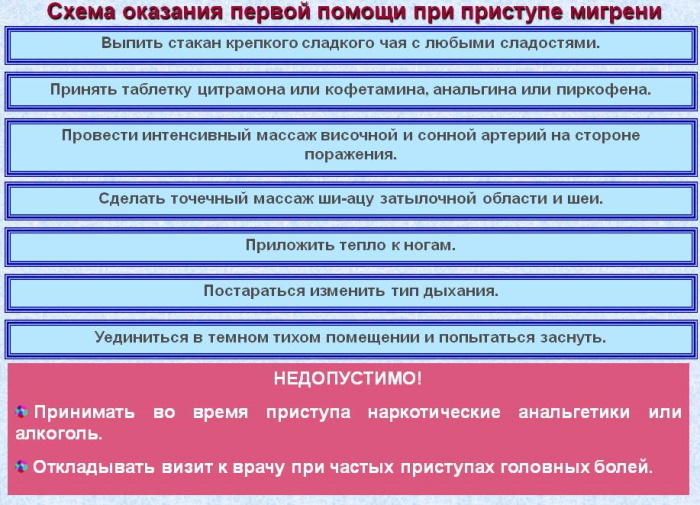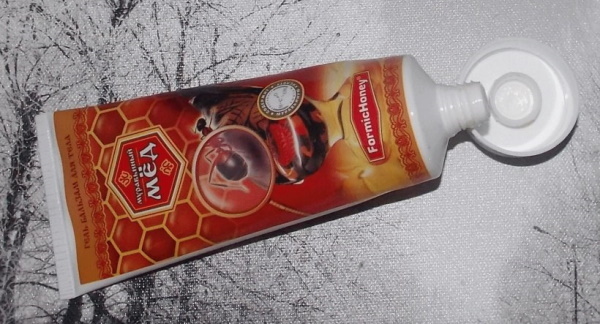Content
- Reasons for the development of de Quervain's syndrome
- The mechanism of development of de Quervain's disease
- What structures are affected in De Quervain syndrome
- Short extensor of the thumb
- The long muscle abducting the thumb of the hand
- Clinical picture, symptoms
- Survey
- Physical examination, palpation
- Amplitude of movement
- Muscle resistance tests
- Muscle length
- Joint mobility
- Specific tests
- Neurological tests
- Circulation
- Treatment
- Conservative treatment
- Surgery
- Laser therapy
- Orthotics and taping
- Shockwave therapy
- Darsonval
- Physiotherapy
- Applying ice / heat
- Massage
- Stretching, development of the range of motion
- Reduced swelling
- Forecasts
- Video about de Quervain's disease
Chronic microtraumatization of the hand can cause de Quervain's disease (tenosynovitis), which is often accompanied by swelling and pain in the area of the thumb. With this pathology, 2 types of treatment are used - surgical and conservative.
Reasons for the development of de Quervain's syndrome
According to scientific research, it occurs in people who have reached the age of 30-55 years. Moreover, women are most often exposed to it, in 1.3% of cases, while in men it is diagnosed only in 0.5%.
Young mothers, who often carry children in their arms, are most susceptible to de Quervain's disease. It is in them that bilateral inflammation occurs, which most often goes away on its own, as soon as the child is "released" from the hands.
The exact cause of the development of de Quervain's disease is still not known.
But orthopedists and traumatologists suggest that factors can contribute to it:
- hereditary predisposition;
- monotonous movement of the first finger of the hand (most often associated with professional activity);
- inflammation;
- finger or hand injuries;
- complications of arthrosis or arthritis;
- hormonal imbalance, most often developing during pregnancy;
- wasting of the muscles of the forearm;
- anatomical deformity of the hand.
Representatives of the following professions are prone to de Quervain's syndrome:
- ironers;
- pianists;
- winder;
- housekeepers;
- painters;
- field workers;
- painters;
- seamstresses;
- stonecutters and many others.
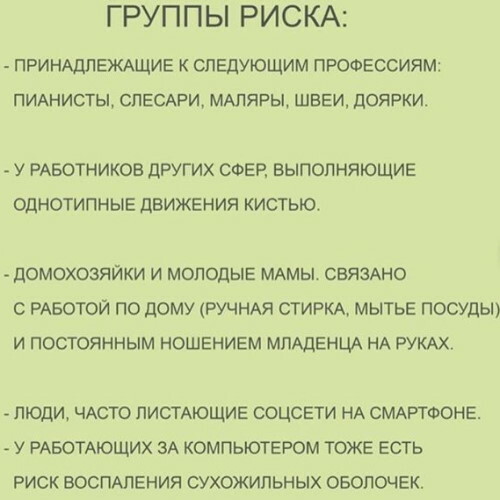
This disease is quite common in professional athletes (in particular, volleyball players). It is also regularly diagnosed in those patients who have previously been diagnosed with lateral or medial epicondylitis (inflammation of the tendons of the elbow joint).
The mechanism of development of de Quervain's disease
Next to the thumb are the tendons that are responsible for mobility and are located in a closed canal. Under different circumstances, they are traumatized, as a result of which an inflammatory process develops in them. Because of this, the tendons swell, which leads to an increase in their diameter. In this case, not only the tendon itself becomes inflamed, but also the channel in which it is located.
As a result, painful sensations appear during the movement of the first finger of the hand. Over time, the condition progresses and there is a decrease in motor activity not only of the finger, but also of the entire hand.
De Quervain's syndrome, the treatment of which is carried out using different methods, most often has an increasing character and usually develops for a long time. The acute form with intense progression is extremely rare.
What structures are affected in De Quervain syndrome
With de Quervain's tenosynovitis, the tendons located near the thumbs and their channels are affected. Both hands are equally susceptible to this pathology, but most often the one that is the leading one, which is subjected to greater stress. It affects the tendons of the short extensor and / or the long muscle.
Short extensor of the thumb
This tendon originates in the interosseous septum of the forearm, the body of the radius at ½ of the posterior surface of its body. Attaches to the base of the proximal phalanx of the first finger of the hand. Provided with blood supply from the posterior interosseous artery, innervation from the radial nerve.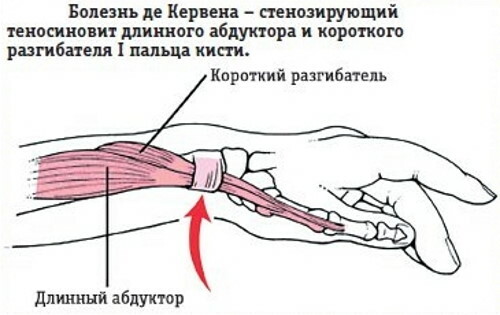
The main functions of this tendon include extension of the thumb and radial deflection of the wrist joint.
The long muscle abducting the thumb of the hand
This tendon originates in the interosseous septum of the forearm, at the back of the ulna and radius. Attaches to the base of the first metacarpal bone. Blood supply comes from the posterior interosseous artery, innervation from the radial nerve.
This tendon is responsible for abduction of the thumb and radial abduction of the wrist joint.
Clinical picture, symptoms
De Quervain's syndrome develops for a long time and without any special symptoms, so patients seek help when the disease has progressed to a chronic form. Acute development occurs in only 8% of cases, most often due to trauma.
The main symptom of this pathology is pain of a different nature:
- when moving and at rest - aching, pressing;
- in a dream - sharp;
- radiating up the shoulder, elbow or forearm;
- with recoil down the outer surface of the thumb.
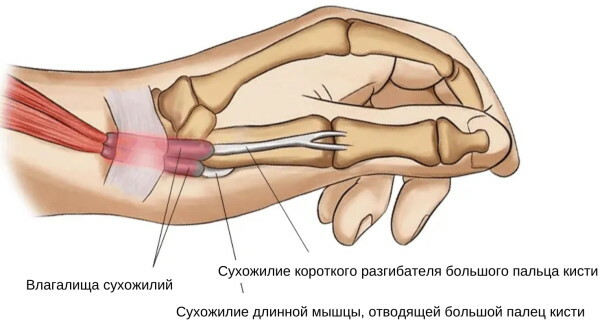
Initially low-intensity pain. They arise only with a strong pull and extension of the first toe. Gradually, the pain increases and appears even with slight movement.
Survey
Various techniques and tests are used to make an accurate diagnosis of de Quervain's syndrome. They help to determine the degree of damage, the intensity of inflammatory processes and whether there are disturbances in the blood supply.
Physical examination, palpation
If you suspect the development of de Quervain's disease, both hands of the patient are performed first.
This helps to assess:
- how pronounced are the changes in the affected hand;
- the intensity of the edema;
- the severity of the anatomical snuffbox.
Usually, with this pathology, the appearance of the skin is within normal limits, an increase in local temperature is not observed. Any changes indicate self-medication and the use of folk and pharmacy warming and local anesthetics.
Palpation helps to determine the presence of painful sensations in the affected area, which intensify in the area of the location of the styloid process of the radius. Slightly below it, the formation of a rounded shape, hard and smooth to the touch, is well palpated. With pressure on the tendon of the first finger, pain is most often absent.
On the sore hand, the degree of limitation of the deviation of the first finger is revealed. To do this, the patient places the palms of both hands with an edge on the table parallel to each other and removes the thumbs. The retraction angle between the healthy and the affected hand usually differs by 40-80 °. When extending the fingers, this is not so noticeable, but still visible.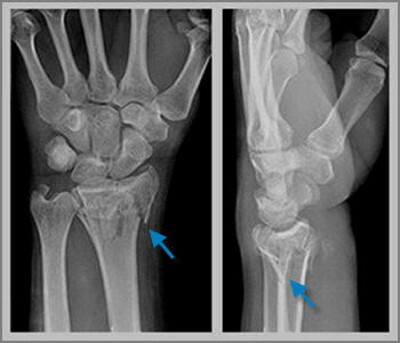
In the second method of assessing mobility, the patient puts his palms on the table and tries to alternately take his hands towards the thumb and little finger. When bending towards the fifth toe, pain is often felt and movement is limited to 30-40 °. When tilted towards the thumb, there are no visual deviations.
Amplitude of movement
The next step in the examination is to assess the range of motion. All deviations from the norm are noted.
During the study, the following indicators are checked:
- opposing the first finger;
- parameters of movements in the cervical spine;
- the ability to deviate to the side in the metacarpophalangeal and metacarpophalangeal joints;
- flexion and extension of the right and left shoulder joints;
- extension and flexion in all joints of all fingers;
- mobility of the hand and elbow joint.
With reduced tendon mobility, a clicking sound is often heard when testing thumb mobility.
Muscle resistance tests
De Quervain's syndrome, which is not treated until after a thorough examination, is often diagnosed with manual muscle testing. During them, the force of compression of the fingers (pinching) and the strength of the wrist grip are assessed.
Muscle length
With this pathology, not only decreased, but also increased joint mobility often occurs. In this case, therapy will be prescribed depending on the type of violation. 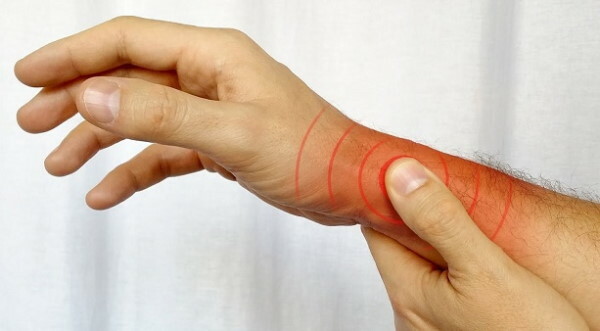 With hypomobility during movement, painful sensations often appear in the area of inflammation.
With hypomobility during movement, painful sensations often appear in the area of inflammation.
Joint mobility
The diagnosis of de Quervain's disease necessarily includes an analysis of the mobility of several joints of the hand:
- intercarpal;
- carpal;
- wrist;
- interphalangeal;
- srednecarpal;
- metacarpophalangeal;
- metacarpal-carpal.
In addition, a separate assessment of the mobility of the thumbs of both hands is carried out.
Specific tests
These tests help confirm or deny the diagnosis.
In examining a patient, the following specific techniques are used:
- assessment of wrist instability;
- Finkelstein test;
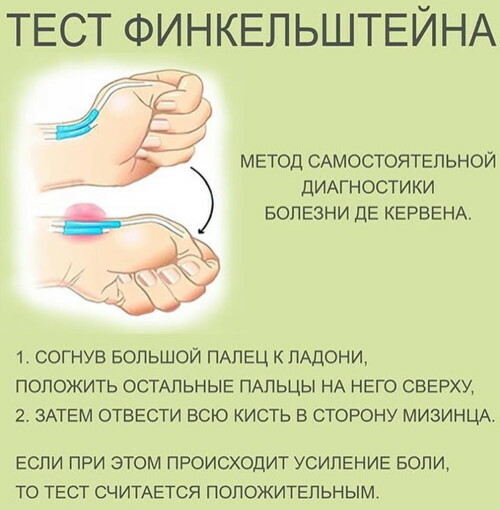
- analysis of the clinical likelihood of cervical (cervical) radiculopathy;
- Grind Test ("Grinding test") to refute the presence of osteoarthritis of the I metacarpal-carpal joint;
- top surface tension test;
- palpation to check for the presence or absence of a scaphoid fracture.
Finkelstein's test helps with almost 100% probability to confirm the development of de Quervain's syndrome.
Neurological tests
Performing neurological tests requires the utmost care, since any inaccuracy is fraught with even greater trauma. There are the following techniques to help diagnose this pathology.
These include:
- upper limb tension test (2 types);
- Tinel's symptom;
- analysis to detect damaged radial nerve;
- test for impaired external sensitivity of the branch of the radial nerve.
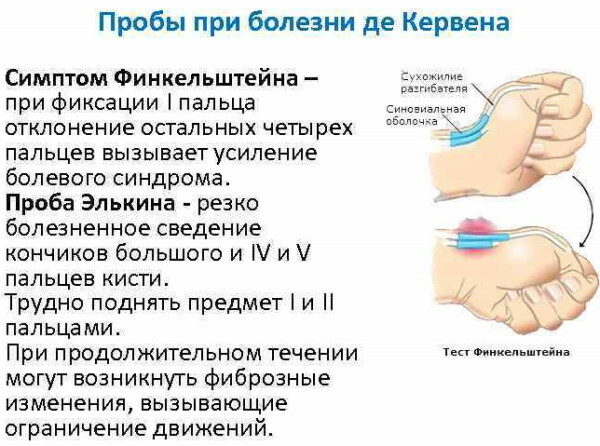
Tinel's symptom helps determine if there is damage to the radial nerve. To do this, a special neurological hammer is tapped several times on the wrist. Nerve damage is indicated by symptoms such as numbness, tingling, and others. Pain during this testing is extremely rare.
Circulation
De Quervain's syndrome, which is treated both at home and in a hospital, requires a mandatory assessment of blood circulation. This examination is aimed at checking capillary filling / blanching, edema and local sensitivity.
Treatment
Therapy de Quervain's tenosynovitis is often carried out using different techniques. The goal is to relieve swelling and pain. This pathology is treated by a traumatologist or orthopedist.
Conservative treatment
This method involves outpatient treatment. A splint made of plastic or plaster is installed on the injured arm, which the patient will need to wear for 1-1.5 months. Then you will need to wear a thumb support for a while.
In parallel, the patient is prescribed non-steroidal anti-inflammatory drugs. They not only relieve inflammation, but also eliminate pain and lower fever.
| Name | Reception scheme |
| Ibuprofen | 1 tablet (200 mg) up to 4 times a day. If necessary, a three-fold dose of 2 tablets at a time can be prescribed.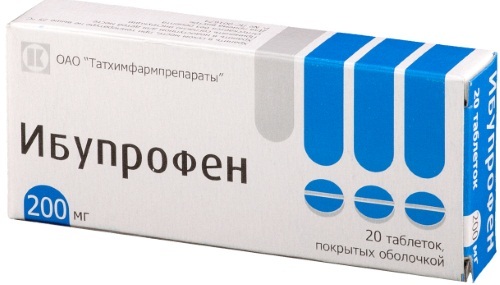
|
| Naproxen | 1-2 (250-500 mg) tablets morning and evening. The daily dosage can be increased to 1750 mg. |
| Meloxicam | Orally - 7.5-15 mg once a day. Rectally - 15 mg once a day. Intramuscularly - in the first days of treatment, 7.5-15 ml. |
For intense pain, corticosteroid injections are prescribed.
Such as:
- Dexamethasone;
- Diprospan;
- Prednisol and others.
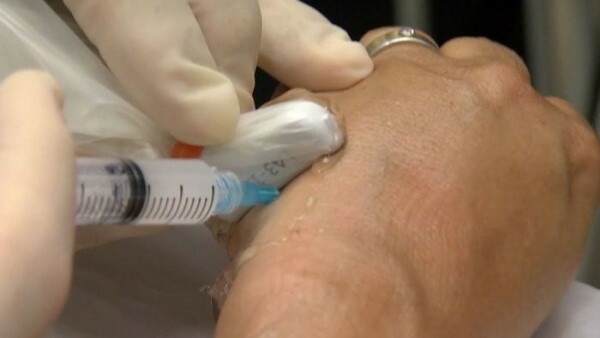
When prescribing medications, the presence of contraindications, the patient's age and concomitant pathologies must be taken into account.
Surgery
In the event that conservative techniques have not yielded a visible positive result, surgery may be indicated. It is carried out in a hospital setting, most often using local anesthesia.
During the operation, the ligament is excised and partially removed. If adherent growths are found on it, they must be cut off. Removal of stitches occurs 8-10 days after the procedure. Full work capacity returns in about 2 weeks from the date of surgery.
During the rehabilitation period, the patient may feel slight numbness or "goose bumps" in the thumb, index and middle fingers, which disappear on their own after 2-3 weeks.
Laser therapy
Laser therapy is used as an additional method in conservative treatment. The main advantage of this method is the almost complete absence of unpleasant sensations during the procedure.
Laser therapy has an effect:
- improves local blood supply;
- accelerates recovery processes;
- activates cell metabolism;
- relieves spasms;
- eliminates inflammation;
- has an analgesic effect.
The course of treatment is no more than 6 sessions. It is not recommended to use laser therapy in the presence of blood diseases, birthmarks, papillomas and other benign neoplasms in the wrist and hand area.
Orthotics and taping
De Quervain's syndrome, which is most often treated on an outpatient basis, requires the use of fixatives. To treat problems with the musculoskeletal system, specialists use 2 methods - orthosis and taping.
The essence of orthotics is to apply a special bandage to the hand, in order to immobilize the joint of the thumb, which will significantly reduce pain. Duration of wearing is 35-40 days. This device is usually used in those patients who are contraindicated on corticosteroid medications.
The task of taping is also to fix the joint, but in this case, adhesive cotton strips (tapes) are used. This method helps relieve pain and swelling, improve joint function.
Shockwave therapy
This technique allows you to quickly get rid of adhesions on the ligaments, while not affecting healthy tissue.
Shock waves help:
- normalize blood flow;
- activate the immune system;
- accelerate recovery;
- improve metabolic processes;
- form new blood vessels;
- relieve inflammation.
Already after the first sessions of shock wave therapy, pain decreases and edema subsides. The full course of treatment usually consists of several sessions with an interval of 6-7 days between them. The procedure takes 20 minutes. It does not have any side effects, except for a slight reddening of the skin, which goes away on its own.
Darsonval
The Darsonval device is intended for the treatment and prevention of various problems of the musculoskeletal system.
The therapy with this device helps:
- relieve inflammation;
- normalize muscle tone;
- relieve pain;
- saturate the tissues with oxygen.
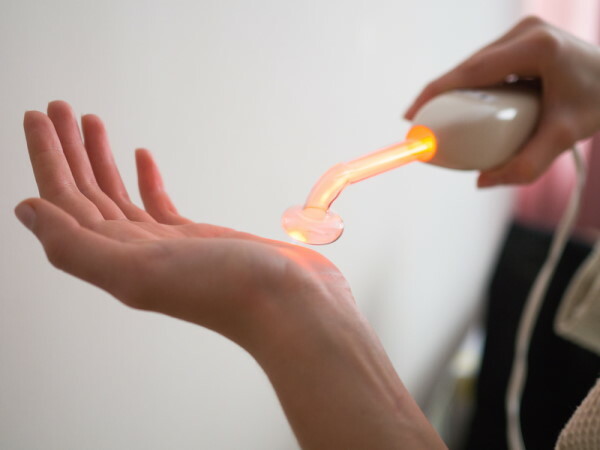
The device can be used both in a hospital and at home. The duration of the procedure is 5-15 minutes. The course of treatment is 10-15 sessions with an interval between each one of 1-2 days.
Physiotherapy
De Quervain's syndrome responds well to treatment if several methods are used at once, including physiotherapy. It helps to quickly get rid of the symptoms of the disease. But there are pathologies that are a direct contraindication to its use.
These include:
- oncology;
- diseases of the circulatory system;
- tachycardia.
Physiotherapy at elevated body temperature is also prohibited. Only a physiotherapist can determine the possibility of its use.
Applying ice / heat
Alternating exposure to heat and cold can help relieve pain and muscle tension.
Massage
Various types of healing massage are widely used to relieve pain and stiffness of muscle tissues in de Quervain's disease.
Stretching, development of the range of motion
This system of exercises is aimed at developing joint mobility and flexibility, stretching the muscles. There are a number of rules that must be followed when doing stretching.
These include:
- Before performing the main exercises, you should warm up for 10-15 minutes. Warm-up movements should be dynamic with a small amplitude.
- When doing stretching exercises, make sure that the movements are smooth and slow.
- Breathing should be even. Stretching should be done with a deep breath.
- Perform 1 exercise in 2-4 repetitions of 30 seconds, gradually increasing the stretching time to 1 minute.
- Exercise intensity, amplitude, and frequency increase gradually.
- It is forbidden to use this gymnastics for severe pain.
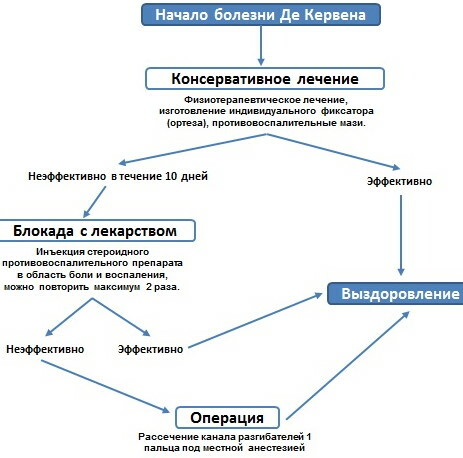
The type and duration of the exercises are selected by the exercise therapy instructor individually. To achieve the maximum positive effect, it is advisable to devote time to classes daily.
Reduced swelling
Several different methods used in the complex help to relieve swelling of the hand and wrist:
- stretching;
- applying a splint on the thumb;
- massage;
- alternate application of heat and cold.
A prerequisite for effective treatment is the use of non-steroidal anti-inflammatory drugs and / or corticosteroid injections.
Forecasts
With timely adequate treatment, the prognosis of complete elimination of de Quervain's disease is quite favorable. Rapid positive dynamics can be achieved in about 50% of cases, both with conservative and surgical treatment.
De Quervain's syndrome occurs quite often, especially in those patients who are engaged in monotonous manual labor. For its treatment, various techniques are used, which, in combination, help to eliminate the symptoms rather quickly. But it should be borne in mind that if the recommendations of the attending physician are not followed, the disease may recur.
Video about de Quervain's disease
Malysheva about de Quervain's disease:

